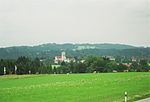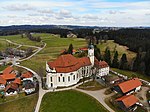Rottenbuch Radio Tower

The Rottenbuch Radio Tower is a transmitting tower of the Vodafone company, sited between Peiting and Rottenbuch in southern Bavaria, Germany. The framework tower, a glued girder binder construction made from European Douglas fir timber, is 66 meters high. The structure is held together by steel pegs. On 18 March 2002 tower construction was started with the excavation of the tower foundations; on 3 June 2002 building of the tower structure began. For this the lower elements of the framework construction were pre-assembled in pairs and then put in place. The missing diagonal elements were then added afterwards. On 21 June 2002 the construction was finished. At this time, the Rottenbuch Radio Tower was the highest wooden tower in Germany (and continued being this until in 2012, the Windkraftanlage Hannover-Marienwerder (a wind power station in Hanover) with a 100m high wooden tower was erected).As of July 2020, a newspaper report said that the tower has to be demolished due to irreparable damage by ants. A replacement tower was planned then to be erected until 2022 In December 2020, this was decided to be a steel construction. However, as of May 2023, neither the demolishion nor the construction of a replacement building is begun.
Excerpt from the Wikipedia article Rottenbuch Radio Tower (License: CC BY-SA 3.0, Authors, Images).Rottenbuch Radio Tower
Schnaitbergweg, Rottenbuch (VGem)
Geographical coordinates (GPS) Address External links Nearby Places Show on map
Geographical coordinates (GPS)
| Latitude | Longitude |
|---|---|
| N 47.756944444444 ° | E 10.931944444444 ° |
Address
Funkturm Rottenbuch
Schnaitbergweg
82401 Rottenbuch (VGem)
Bavaria, Germany
Open on Google Maps











